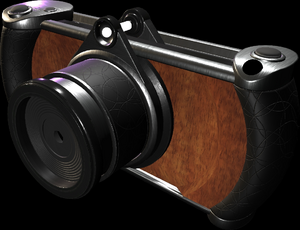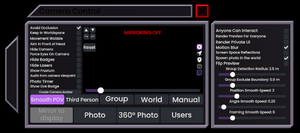
The Camera is the default available camera a user can bring out (either from a link, file import, or from the Resonate Essentials folder).
This camera comes in two flavors, a regular photo camera and a stream camera. The camera itself visually does not have any difference between the two. The difference comes from the added functionality by streaming from this camera. More details on this section describing the Streaming Camera.
Camera
The camera has a set of features and functions.
Top of the camera
- The top button on the right takes the picture immediately. Pictures will spawn and stack below the camera after each picture taken.
- The top button on the left shows the preview of what the camera sees. Great for group photos.
Back of the Camera
Behind the camera is a large preview window, showing you what is going to be taken by this camera, along with a set of options on the left, a zoom slider on the right, and information on the bottom. Here is what each thing does:
- Camera Mode Menu: There is 4 modes for the camera. Normal Mode, Stereoscopic Mode, 360 Mode, Focus Mode.
- Normal Mode takes normal pictures.
- Stereoscopic Mode takes pictures that creates a 3D effect. This is essentially 2 images, taken at slightly different angles, to create this illusion. The effect cannot be seen in Desktop Mode and only shows a regular image.
- 360 Mode takes a panoramic image. This is useful for making skyboxes.
- Focus Mode makes the camera shoot a laser, anything in front of that laser will be the focused object for the picture. This also makes the image have a transparent background.
- Reolusion: This controls the resolution or quality of the image once taken by the camera.
- Filter: Shows a menu of a selection of filters you can use for the pictures.
- No Filter: Turns the filter mode off.
- (F1) HDR: This filter adds in more contrast to the image and color, making it have that HDR effect.
- (F2) Grayscale: The image is monochrome black & White.
- (F3) Sepia: The image is monochrome golden yellow, giving the effect of an old-time photo.
- (F4) Invert: The image is inverted with a spectrum of colors.
- Direction: This provides a menu to adjust the cameras view direction. The arrows are presents to view rotations of this camera (great for landscape or portrait mode), and the automatic and manual buttons are for further adjustments.
- Grid: This shows a menu with buttons that toggles the grid, allowing the photographer to use the composition and rule-of-thirds for the picture taking.
- Settings: Shows a menu for other settings for the camera, such as a timer, showing the frustum, toggling a light, and showing the group photo preview. There are other settings here under the described settings.
- Information footer: shows the information to the user of what settings and values this camera is showing.
- Zoom Slider: A slider that controls the camera zoom (or the "Focal Length") for the image. The default starts at
60.
Front of the camera
- There is a zoom ring for the camera (called a "Focal Length Ring"), that zooms in or out when grabbed and used. This also adjusts the slider on the back of the camera.
Streaming Camera

The camera has another major feature, streaming with the camera. This can be utilized by going to the Dash and on to the home tab, then clicking on the button labeled "Camera / Streaming". This will pull up both the camera and the camera control panel.
Camera Behaviors
There is quite a bit of controls and settings, here is what they all do:
- Avoid Occlusion: When the camera is behind a wall or anything that is collidable, it will zoom the view in front of it to focus on the subject. This will not work in manual mode.
- Keep In Worldspace: This keeps the camera in worldspace.
- Movement Wobble: This makes the camera have gradual movement in different positions around the subject. This only works with Third Person or Group modes.
- Aim In Front of Head: This aims the camera view more towards the user's head, specifically a few inches/centimeters in front of the head proxy's forward direction. This only works for the Third Person, Group, and World modes.
- Hide Camera: This hides the camera visual, but will still track the subject or stay in place as before with manual mode or with camera anchors.
- Focus Eyes On Camera: This makes the user's avatar's eyes lock on to the camera position.
- Hide Badges: This hides the user's badges (including the nameplate) from the camera preview and any pictures taken.
- Hide Lasers: This hides the user's lasers from the camera preview and any pictures taken.
- Show Frustum: This shows where the camera is aimed and focused at in 3D space.
- Audio from camera viewpoint: This moves your audio listeners (your audio output or ears) to where the camera is, overriding thier position to take in audio from. This can be checked for using the local output category in ProtoFlux.
- Photo Timer: Sets up the camera to have a timer when the photo button is pressed. The timer can be set to have a preset amount of time or a custom time, found on the back of the camera itself.
- Show Live Badge: Shows the live badge to let other user's know that you are live and streaming to somewhere external from Resonite.
Camera Anchors
The camera anchor button spawns a camera anchor from the position at the camera. This camera anchor is meant to be placed in different parts of the world and to have your camera snap to where you put this anchor. Click or use primary on the camera anchor and the camera will jump to that exact position and rotation, as well as the camera mode changing to Manual.
While the camera is on the camera anchor, the camera will smoothly move as you move it around.
To get the camera off the anchor, just change the camera mode to anything other than Manual.
Camera Modes
There are several modes this camera can be in, here is a what they do:
- Smooth POV: This makes the camera use the user's point of view, seeing what they see. Keep in mind that this will use the user's eye position, and if the eyes are behind something like a long avatar nose or large hair, the camera will render that in the preview and photo.
- Third person: The camera will focus the user as the subject, and is the default mode this camera will be in when spawned out.
- Group: The camera will focus on a group of users who are close together and close to the main user that spawned out the camera.
- World: This keeps the camera locked in place in the world, but still focusing on the subject, the user that spawned out the camera.
- Manual: This makes the camera become a normal camera in the sense that it does not focus on anything. All the other settings will still apply except for movement based settings.
Photo Controls
The row of buttons on the bottom of the control panel allows for photo control and picture taking. Here is what they do:
- Mirror to Display: Mirrors the preview window display.
- Photo: This takes a picture immediately (if the photo timer is selected, it uses the timer instead, then takes a picture).
- 360 Photo: This takes a 360 picture immediately (if the photo timer is selected, it uses the timer instead, then takes a picture).
- Users: This opens another panel below this control panel, showing a list of users and the controls for them. This can let the user control how other users sound (by changing their voice mode or volume for the audio output), as well as making them visible in the preview or stream.
Preview Window
The preview window shows the subject that the camera is focusing on, and also contains a few more controls that the user can adjust, along with further settings, here is what they are:
- Some modes allow the user to adjust the way the camera is floating in front of them. On the top left of the preview window, there are up and down arrows to adjust the pitch (the up and down angle of the camera), the plus and minus buttons to push or pull the camera from the subject, and the rotate buttons that rotate around the subject along the yaw (left or right movement and position).
- The bottom of the preview window has the zoom control (also known as the "Focal Length") for the camera.
- The right side of the preview window has more settings, specifically on the connection to streaming applications and how the camera control panel works.